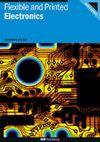喷墨打印低温共烧陶瓷:定制 LTCC 的工艺开发
IF 3.2
4区 工程技术
Q3 MATERIALS SCIENCE, MULTIDISCIPLINARY
引用次数: 0
摘要
本文研究了如何利用数字印刷技术制造低温共烧陶瓷(LTCC)。由于低温共烧陶瓷具有低介电损耗、低介电常数、低热膨胀系数等优异性能,同时在恶劣环境(高温、潮湿和辐射)下具有高可靠性,因此为天线、传感器或执行器等应用提供了巨大的机遇。LTCC 是多层电路,通常通过丝网印刷进行功能化。本出版物研究了用数字印刷工艺(如喷墨和气溶胶喷射印刷)取代丝网印刷的问题,以促进资源友好型和可定制型 LTCC 的制造。数字印刷技术的使用不仅简化了小规模生产和开发流程,而且还具有实现微型化(小至个位数微米)的优势。本出版物研究了数字印刷工艺、通孔填充、层压工艺、850 ℃ 共烧以及在烧结的 LTCC 上进行印刷。在绿色 LTCC 带上印刷了三层纳米银墨水,经过共烧后,100% 的嵌入式印刷结构具有导电性。通过喷墨打印填充通孔的研究发现,最重要的工艺参数是通孔的聚类、活性喷嘴的数量和基底温度。在烧结的 LTCC 上进行喷印显示出很高的精度,而在 600 °C 下烧结则实现了喷印结构与 LTCC 的牢固粘合。这些成功的研究成果最终为完全无掩模结构的多层 LTCC 提供了一条工艺链。本文章由计算机程序翻译,如有差异,请以英文原文为准。
Inkjet-printed low temperature co-fired ceramics: process development for customized LTCC
This paper investigates the utilization of digital printing technologies for the fabrication of low temperature co-fired ceramics (LTCC). LTCC offer great opportunities for applications such as antennas, sensors or actuators due to their outstanding properties like low dielectric loss, low permittivity, low coefficient of thermal expansion and at the same time high reliability in harsh environments (heat, humidity, and radiation). LTCC are multilayer circuits that are typically functionalized by screen-printing. This publication investigates the replacement of screen-printing by digital printing processes, such as inkjet and Aerosol Jet printing, to facilitate a more resource-friendly and customizable manufacturing of LTCC. The use of digital printing technologies not only streamlines small-scale productions and development processes but also offers the advantage of achieving miniaturization down to single-digit microns. In this publication, digital printing processes, filling of vias, lamination processes, co-firing at 850 °C and printing on fired LTCC were investigated. Three layers of nanoparticle silver ink were printed on green LTCC tape and 100% of the embedded printed structures were conductive after co-firing. Filling of vias with inkjet printing was investigated and the most important process parameters were found to be the clustering of vias, the amount of active nozzles and the substrate temperature. Printing on fired LTCC demonstrated high precision, and sintering at 600 °C achieved strong adhesion of printed structures to LTCC. These successful findings culminate in presenting a process chain for fully maskless structured, multilayer LTCC.
求助全文
通过发布文献求助,成功后即可免费获取论文全文。
去求助
来源期刊

Flexible and Printed Electronics
MATERIALS SCIENCE, MULTIDISCIPLINARY-
CiteScore
4.80
自引率
9.70%
发文量
101
期刊介绍:
Flexible and Printed Electronics is a multidisciplinary journal publishing cutting edge research articles on electronics that can be either flexible, plastic, stretchable, conformable or printed. Research related to electronic materials, manufacturing techniques, components or systems which meets any one (or more) of the above criteria is suitable for publication in the journal. Subjects included in the journal range from flexible materials and printing techniques, design or modelling of electrical systems and components, advanced fabrication methods and bioelectronics, to the properties of devices and end user applications.
 求助内容:
求助内容: 应助结果提醒方式:
应助结果提醒方式:


